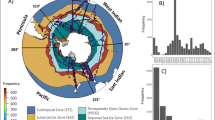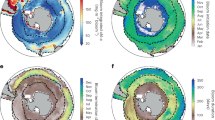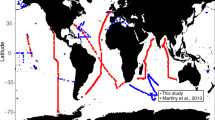Abstract
Arising from D. G. Boyce, M. R. Lewis & B. Worm Nature 466, 591–596 (2010)10.1038/nature09268; Boyce et al. reply
Phytoplankton account for approximately 50% of global primary production, form the trophic base of nearly all marine ecosystems, are fundamental in trophic energy transfer and have key roles in climate regulation, carbon sequestration and oxygen production. Boyce et al.1 compiled a chlorophyll index by combining in situ chlorophyll and Secchi disk depth measurements that spanned a more than 100-year time period and showed a decrease in marine phytoplankton biomass of approximately 1% of the global median per year over the past century. Eight decades of data on phytoplankton biomass collected in the North Atlantic by the Continuous Plankton Recorder (CPR) survey2, however, show an increase in an index of chlorophyll (Phytoplankton Colour Index) in both the Northeast and Northwest Atlantic basins3,4,5,6,7 (Fig. 1), and other long-term time series, including the Hawaii Ocean Time-series (HOT)8, the Bermuda Atlantic Time Series (BATS)8 and the California Cooperative Oceanic Fisheries Investigations (CalCOFI)9 also indicate increased phytoplankton biomass over the last 20–50 years. These findings, which were not discussed by Boyce et al.1, are not in accordance with their conclusions and illustrate the importance of using consistent observations when estimating long-term trends.
This is a preview of subscription content, access via your institution
Access options
Subscribe to this journal
Receive 51 print issues and online access
$199.00 per year
only $3.90 per issue
Buy this article
- Purchase on Springer Link
- Instant access to full article PDF
Prices may be subject to local taxes which are calculated during checkout

Similar content being viewed by others
References
Boyce, D. G., Lewis, M. R. & Worm, B. Global phytoplankton decline over the past century. Nature 466, 591–596 (2010)
Reid, P. C., Colebrook, J. M., Matthews, J. B. L. & Aiken, J. The Continuous Plankton Recorder: concepts and history, from plankton indicator to undulating recorders. Prog. Oceanogr. 58, 117–173 (2003)
Edwards, M., Reid, P. C. & Planque, B. Long-term and regional variability of phytoplankton biomass in the Northeast Atlantic (1960–1995). ICES J. Mar. Sci. 58, 39–49 (2001)
Head, E. J. H. & Pepin, P. Spatial and inter-decadal variability in plankton abundance and composition in the Northwest Atlantic (1958–2006). J. Plankton Res. 32, 1633–1648 (2010)
Reid, P. C., Edwards, M., Hunt, H. G. & Warner, A. J. Phytoplankton change in the North Atlantic. Nature 391, 546 (1998)
Raitsos, D. E., Reid, P. C., Lavender, S. J., Edwards, M. & Richardson, A. J. Extending the SeaWiFS chlorophyll data set back 50 years in the northeast Atlantic. Geophys. Res. Lett. 32, L06603 (2005)
McQuatters-Gollop, A. et al. A long-term chlorophyll dataset reveals regime shift in North Sea phytoplankton biomass unconnected to nutrient levels. Limnol. Oceanogr. 52, 635–648 (2007)
Saba, V. S. et al. Challenges of modeling depth-integrated marine primary productivity over multiple decades: a case study at BATS and HOT. Global Biogeochem. Cycles 24, GB3020 (2010)
Kahru, M., Kudela, R., Manzano-Sarabia, M. & Mitchell, B. G. Trends in primary production in the California Current detected with satellite data. Geophys. Res. Lett. 114, C02004 (2009)
Batten, S. D. et al. CPR sampling: the technical background, materials and methods, consistency and comparability. Prog. Oceanogr. 58, 193–215 (2003)
Leterme, S. C., Seuront, L. & Edwards, M. Differential contribution of diatoms and dinoflagellates to phytoplankton biomass in the NE Atlantic Ocean and the North Sea. Mar. Ecol. Prog. Ser. 312, 57–65 (2006)
McQuatters-Gollop, A. et al. How well do ecosystem indicators communicate the effects of anthropogenic eutrophication? Estuar. Coast. Shelf Sci. 82, 583–596 (2009)
Gregg, W. W. & Conkright, M. E. Decadal changes in global ocean chlorophyll. Geophys. Res. Lett. 29, 1730 (2002)
Antoine, D., Morel, A., Gordon, H. R., Banzon, V. F. & Evans, R. H. Bridging ocean color observations of the 1980s and 2000s in search of long-term trends. Geophys. Res. Lett. 110, C06009 (2005)
Hátún, H. et al. Large bio-geographical shifts in the north-eastern Atlantic Ocean: From the subpolar gyre, via plankton, to blue whiting and pilot whales. Prog. Oceanogr. 80, 149–162 (2009)
Author information
Authors and Affiliations
Corresponding author
Ethics declarations
Competing interests
The authors declare no competing financial interests.
PowerPoint slides
Rights and permissions
About this article
Cite this article
McQuatters-Gollop, A., Reid, P., Edwards, M. et al. Is there a decline in marine phytoplankton?. Nature 472, E6–E7 (2011). https://doi.org/10.1038/nature09950
Received:
Accepted:
Published:
Issue Date:
DOI: https://doi.org/10.1038/nature09950
This article is cited by
-
The hidden influence of large particles on ocean colour
Scientific Reports (2021)
-
Coupling ocean–atmosphere intensity determines ocean chlorophyll-induced SST change in the tropical Pacific
Climate Dynamics (2021)
-
Global picophytoplankton niche partitioning predicts overall positive response to ocean warming
Nature Geoscience (2020)
-
Machine learning identifies a strong association between warming and reduced primary productivity in an oligotrophic ocean gyre
Scientific Reports (2020)
-
Scientists’ warning to humanity: microorganisms and climate change
Nature Reviews Microbiology (2019)
Comments
By submitting a comment you agree to abide by our Terms and Community Guidelines. If you find something abusive or that does not comply with our terms or guidelines please flag it as inappropriate.



